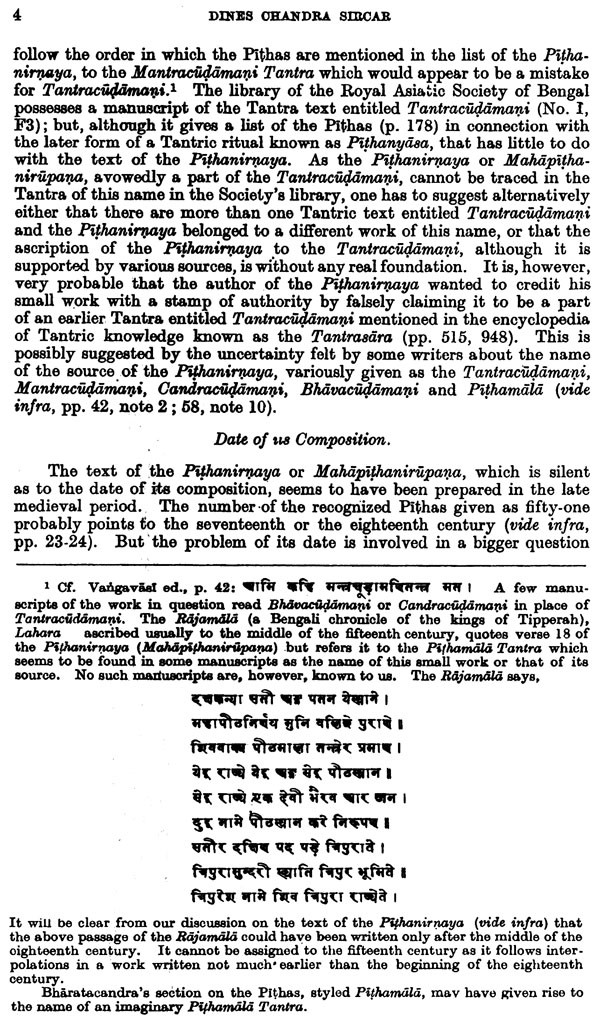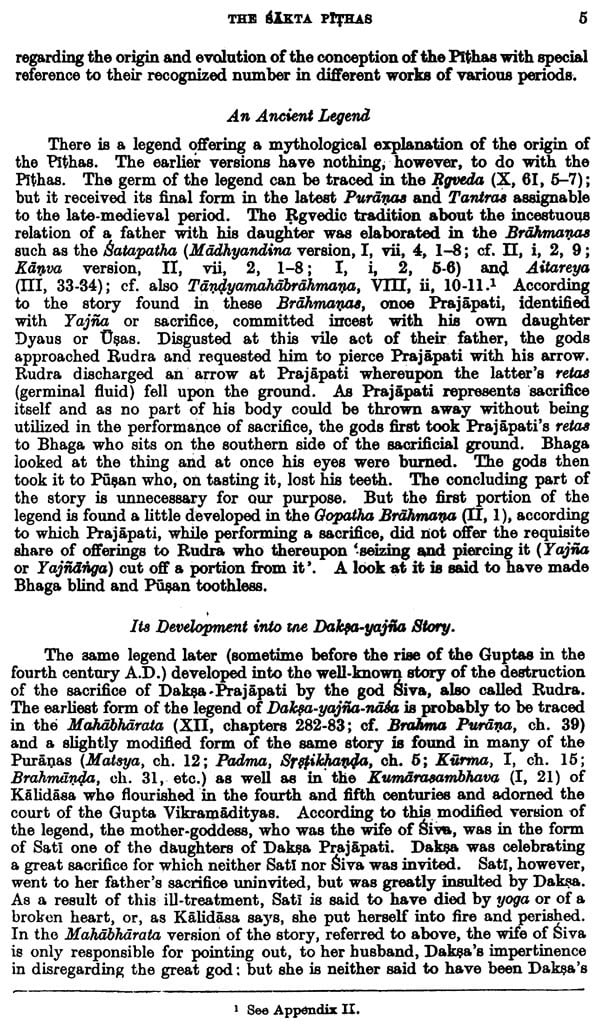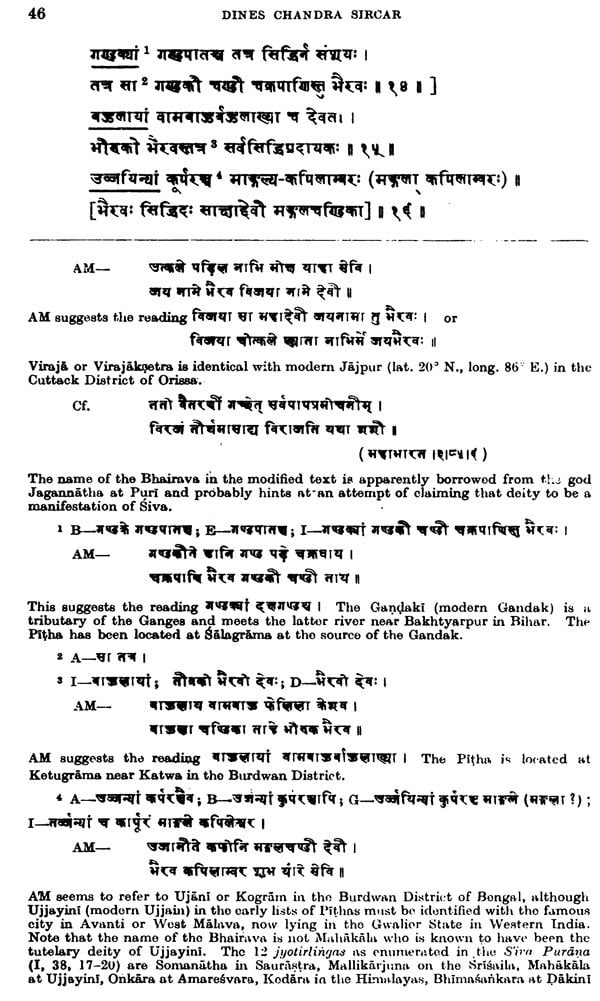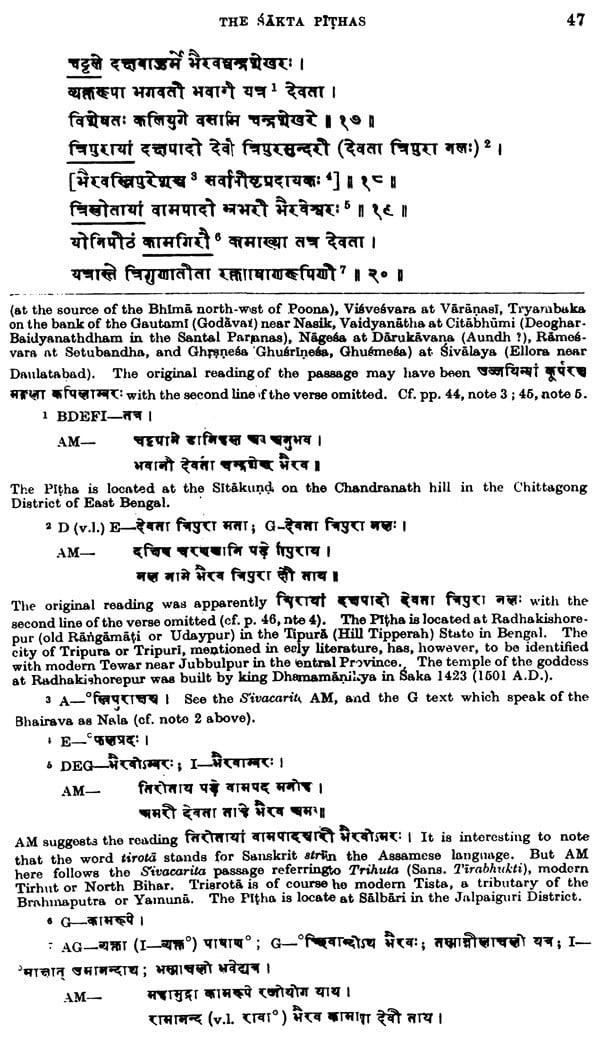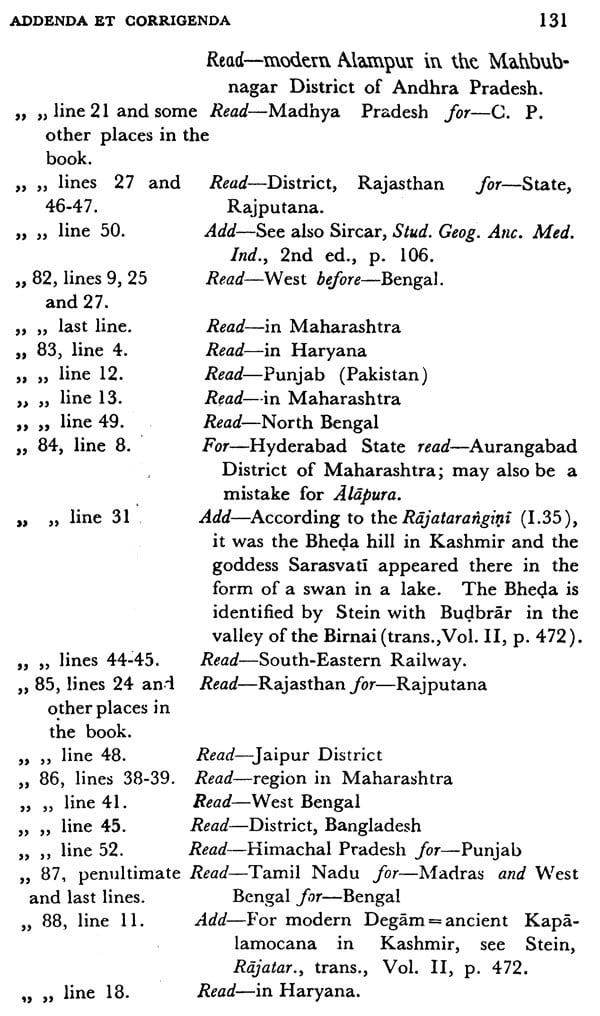
The Sakta Pithas (Rare Book)
Book Specification
| Item Code: | IDE800 |
| Author: | D.C. Sircar |
| Publisher: | MOTILAL BANARSIDASS PUBLISHERS PVT. LTD. |
| Language: | English |
| Edition: | 2004 |
| ISBN: | 8120808797 |
| Pages: | 140 |
| Cover: | Hardcover |
| Other Details | 9.0 inch X 6.0 inch |
| Weight | 330 gm |
Book Description
The holy places, associated with the Mother Goddess and spread over various parts of the Indian subcontinent, have been popular pilgrim spots for a long time. According to some late Tantric texts ascribable to Eastern India, the number of such Sakta-Tirthas is fifty-one, and the present monograph is a dissertation on the origin and development of this conception. Thus it is, at the same time, the study of a number of Tantric and other texts as well as of certain problems of Tantric religion and of historical geography. It is unique in its approach because Tantra Studies have not progressed satisfactory so far on scientific lines. The present monograph has been regarded by a competent authority as 'a mode of accurate and penetrating investigation', which has brought honour to its author.
Dr. Dines Chandra Sircar was formerly Government Epigraphist for India in the Archaeological Survey and Carmichael Professor and Head of the Department of Ancient Indian History and Culture, Calcutta University. He was General President of the All-India Oriental Conference in 1972 and had previously presided over sessions of the Numismatic Society of India and Sections of the Indian History Congress and the All-India Oriental Conference, besides being Chief Guest at the All-Orissa History Congress.
Prof. Sircar has written on most aspects of early Indian History during the past four decades. Besides editing a large number of volumes of different types, he has published numerous books and monographs and more than a thousand papers, notes and reviews appearing in various periodicals in India and abroad.
The Sakta Pithas by Dr. D. C. Sircar, which is limited and precise in scope but has a wide appeal, brings honour to the young historian of Calcutta. Its basis is a critical edition of the Pithanirnaya or Mahapithanirupana which is a short treatise of the late period describing the fiftyone pilgrim spots associated with thc Mother Goddess under some of her various names. Each one of the pithas is mentioned along with a particular from of the Goddess and that of Siva associated with it.
The said text passes as a chapter of the Tantrac udamani and resembles some others, so that a plausible edition, based on six manuscripts and four source materials which Dr. Sircar's diligence has succeeded in grouping together, was philologically realisable. The editor adds a reconstructed text, based mainly on a Bengali version, and furnishes other useful matters in appendices, one of them containing an index of the pithas with necessary identifications of the localities.
But what doubtless deserves much more attention is the erudite study in the introduction, wherein the author recapi- tulates what is known or may be presumed about the problem of the pithas. Leaving aside minor indications, the legend which seeks to explain the origin of the pithas is the well-known epico- puranic account of Daksa's sacrifice, interrupted by Siva's wrath. The story seems to have developed out of certain allusions in the Brahmanas referring to the peculiar misfortunes of Bhaga and Pusan. In the later Puranas and the Purana-type Tantras, the image of Visnu cutting off, part by part, Sati's corpse borne on Siva's shoulder has been grafted on this legend. The severed parts of Sati's body fell on the earth and each formed a pitha, a cult having come to be crystallised on it. Dr. Sircar recalls in this connection the Buddhist legends about the Buddha's relics and the more distant Greek version of the Osiris myth. We see here, once again, that a cult, quite well localiscd geographically, develops on absolutely mythical conceptions.
. - Certain pithas appear to be associated more especially with the breasts and the female organ of the Goddess, probably analogous to the conception of the phallic emblem of Siva. Whatever that may be, the religious crystallisation seems to have taken place originally on the basis of a group of 4 pithas at a time which, according to Dr. Sircar, may coincide with the appearance of the early Tantras. These 4 pithas are supposed to represent the four cardinal points though, from the beginning, the region of Kamarupa (Assam) enjoyed a privileged position in the scheme. Gradually there appeared 7 pithas, then 10, then 18 (a sanctified number), ultimately (through the inter- mediate numbers 42, 50 and 51) as many as 108 (an equally expected number). The Pithanirnaya is based on a list of 42, which was later enlarged, by the inclusion of the 10 mahavidyas of the Mother Goddess, the counterpart of the 10 avataras of the Visnuite cycle.
In an appendix, Dr. Sircar discusses the evidence for determining the date of the celebrated encyclopaedic treatise Tantrasara (first half of the 17th century). Another appendix, the scope of which is more general than novel, deals with the development of the Sakti cult from Vedic times going as far back as the Mohen-jo-daro motifs, the interpretation of which is, however, not quite decisive.
I may specially recommend this study of the pithas as a model of accurate and penetrating investigation.
Tantric studies have not much progressed in India. The author of the present monograph originally approached the Tantra literature as a student of ancient and medieval Indian geography, although the subject under discussion in the following pages soon proved to be equally interesting from the viewpoint of the religious life of India. A Tantra text on the Sikta Ptthas, entitled Pithanirnya or Mahapithanirupana, has been echted here with notes and an attempt has been made in that connection to trace the history of the Pitha conception with reference not only to the Puranic legend in theoretical explanation of the origin of the Pithas but also to the real basis of the conception itself. No less than six manu- scripts and four published sources have been utilized in editing the .pitha- nirnaya( Mahapithanirupana) A reconstructed text of the original work has 'been given in as Appendix, while a large number of relevant texts has been quoted either in the notes or in the Appendixes, The author has also discussed, however summarily, the location of several hundrdes of tirthas or holy places, mentioned in various works as Pithas. Much, un- fortunately, still remains to be done in this direction. Any suggestion form the readers for the improvement of the work will be carefully considered and gratefully acknowledged.
The author is extremely thankful to Prof. H. C. Raychaudhuri and Dr. j. N. Banerjea of the Calcutta University, who have taken interest in the preparation of the' monograph and have offered some valuable suggestions. His thanks are also due to Drs. R. C. Majumdar, I. B. Banerji and B. K. Ghosh for some help and suggestions. Mr. S. K. Saraswati has laid the author under a debt of gratitude by lending him a valuable manu- script (MS. G) of the Pithanirnaya from his own collection. As however, the manuscript was received after the monograph had been ready for the press, it has been utilized mainly in the notes on the text and in re- constructing the probable original text of the work for Appendix I-A.
Finally, the author thanks the authorities and managment of the Royal Asiatic Society of Bengal and the Baptist Mission Press, Calcutta.
| Foreword (Louis Renou) | vii |
| The Pithanirnaya or Mahapithanirupana | 3 |
| Date of its Composition | 4 |
| An Ancient Legend | 5 |
| Its Development into the Daksa-yajna Story | 5 |
| Further Development of the Legend to explain the Origin of the Pithas | 6 |
| Conception of the Yonikunda and Stanakunda associated with that of the Linga | 7 |
| Some Early Tirthas associated with the Limbs of the Mother-goddess | 8 |
| The Tradition about Four Pithas | 11 |
| The Tantric Schools of North -Western and Eastern India | 15 |
| Different Traditions regarding the Number of the Pithas | 17 |
| Evidence of the Jnanarnava and the Tantrasara regarding the Number of the Pithas | 20 |
| The tradition about 108 Pithas | 24 |
| Freedom of the Writers on the Pithas from any common Tradition | 32 |
| The List of the Pithas in the Pithanirnaya (Mahapithanirupana) | 35 |
| Modification of the Pithanirnaya (Mahapithanirupana) in the Sivacarita | 38 |
| List of the Pithas (Mahapithas) and Upapithas in the Sivacarita | 39 |
| Materials utilized in the Present Edition of the Pithanirnaya (Mahapithanirupana) | 41 |
| Text of the Pithanirnaya (Mahapithanirupana) | 42 |
| Appendix I - A. Probable Original Text of the Pithanirnaya (Mahapithanirupana) Reconstructed on the basis of Manuscript G and the Annadamangala | 59 |
| B. Modified Text of the Pithanirnaya as found in Manuscript H | 61 |
| Appendix II - Puranic Text containing 108 Names of the Mother-goddess (Namastottarasatam) | 66 |
| Appendix III - Evolution of the Daksayajna Story (Daksayajna-katha-mulam | 70 |
| Appendix IV - Date of the Tantrasara | 74 |
| Appendix V - An Index of Pithas | 80 |
| Appendix VI - Siva and Sakti in the Orthodox Indian Pantheon | 100 |
Book's Contents and Sample Pages
